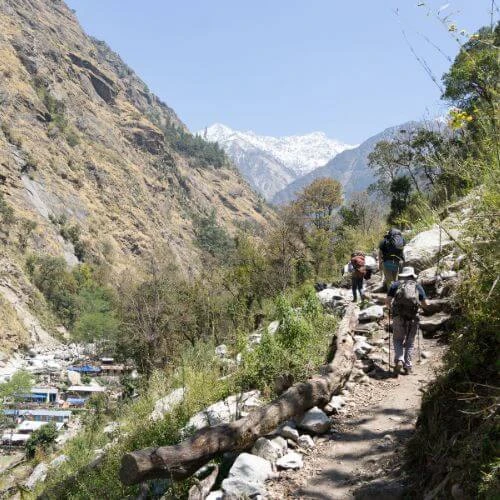Costa Rica
Costa Rica is a famous eco-tourism destination known for its forests and national parks. It is one of the best green destinations for 2025, recognized for preserving nature and promoting eco-friendly practices. Although Costa Rica comprises just 0.03% of the surface of the Earth, it is home to approximately 5% of the world's biodiversity. The country contains a number of ecosystems, ranging from rainforests to cloud forests, beaches, and mangroves great experiences for nature lovers. It has protected 28% of its land through national parks and wildlife reserves. Costa Rica’s national motto, "Pura Vida" (Pure Life), reflects its focus on living in harmony with nature and supporting responsible tourism.

Visitors can enjoy eco-friendly activities in Costa Rica such as:
- Hiking in rainforests and the Monteverde Cloud Forest Reserve
- Visiting Tortuguero National Park, known for its sea turtles
- Watching sea turtles nest on Caribbean beaches
- Touring coffee farms with sustainable practices
- Bird watching
- Learning about local culture and traditions
Bhutan
Bhutan is the smallest country in the Himalayas, which is famous for the protection of the environment and culture and has been one of the most eco-friendly places to visit. It has a very special kind of tourism policy, which goes under the name "High Value, Low Impact," meaning allowing only a few high-spending tourists who have a lesser impact on the environment. Except for those tourists from India, Bangladesh, and the Maldives, all other tourists must book their trips through accredited tour operators. They have also been charging a certain daily fee known as the Sustainable Development Fee, which supports free healthcare, education, and environmental protection for all Bhutanese citizens.Beautiful forests, snowy mountains, and rare animals like snow leopards and red pandas can be found in Bhutan. Its constitution guarantees that at least 60% of the country shall always be under the cover of forests. Bhutan absorbs more carbon dioxide than it emits, making it the only carbon-negative nation on Earth.

Visitors can experience the best eco-friendly activities in Bhutan such as
- Hiking to famous sites like Tiger's Nest Monastery
- Visiting local farms and trying organic Bhutanese food
- Learning traditional crafts from local artisans
- Birdwatching in protected forests
- Staying in locally owned hotels that follow eco-friendly practices
New Zealand
New Zealand is been the most famous eco-travel destination in the world. It is a country in the South Pacific famous for its beautiful landscapes of fjords, glacier lakes, snowy mountains, and long beaches making New Zealand a paradise for eco-tourism, focusing on nature protection and at the same time offering amazing experiences for visitors.About 30% of New Zealand's land is under protection, comprising national parks, conservation areas, and marine reserves. Places such as Fiordland National Park and Abel Tasman National Park can be enjoyed by visitors in a responsible way. The country encourages sustainable travel, with eco-friendly places to stay, responsible wildlife tours, and green transportation, including electric cars and bikes.

Visitors can experience the best eco-friendly activities in New Zealand, such as
- Hiking/walking trails within national parks, such as Fiordland and Abel Tasman.
- Cycling on routes with great views and eco-friendly bike trails.
- Visiting geothermal parks to see geysers and hot springs.
- Star gazing in certified dark-sky reserves.
- Exploring wildlife sanctuaries and viewing native species such as kiwis and seals.
Iceland
Iceland is among one of the top environment-friendly destinations in the world. The country is famous for its beautiful landscapes including glaciers, volcanoes, and waterfalls. To protect its natural beauty, Iceland has taken many steps to ensure tourism does not harm the environment.
One of the main reasons Iceland is an eco-friendly country is its use of renewable energy. Almost 100% of the country's electricity comes from clean energy sources like geothermal and hydropower. This means that hotels, restaurants, and other tourist services use sustainable energy, reducing pollution. Even the famous Blue Lagoon is an example of sustainable resource use, as it uses geothermal seawater from nearby power plants.The government also promotes the use of electric vehicles and eco-friendly transportation for tourists. This helps reduce air pollution and makes travel in Iceland more sustainable. Iceland has many national parks and protected areas, such as Pingvellir National Park and Vatnajokull National Park. Strict rules are in place to protect these areas from too many visitors. Tourists are encouraged to stay on marked paths, avoid disturbing wildlife, and follow the “Leave No Trace” rule. These efforts help protect Iceland’s delicate ecosystems and keep its nature untouched. 
Visitors can experience the best eco-friendly activities in Iceland such as
- Enjoy relaxation in natural hot springs, like the Blue Lagoon or Reykjadalur Hot Springs, whose water is preheated by geothermal energy in a very natural and highly sustainable manner.
- Explore Iceland's stunning landscapes with electric cars that are ready and available for tourists.
- Icelandic protected areas, such as Þingvellir National Park and Vatnajökull National Park, have exceptionally beautiful hiking trails that are well looked after with as little environmental impact as possible, thus enabling guests to enjoy this nature given to them.
- Tourists can enjoy whale watching and bird watching in Iceland, where sustainable tourism practices ensure that wildlife is respected and protected.
- One of the best ways to tour around and enjoy Iceland's scenic routes with minimal carbon footprint is by cycling. Many companies offer eco-friendly bike tours to see the best of Iceland's landscape.
- Sustainable tourism practices are used for glacier hikes and ice-caving tours, allowing visitors to experience Iceland's glaciers while preserving their natural beauty.
The Azores Island
The Azores Islands comprise nine beautiful volcanic islands in the Atlantic Ocean that belong to Portugal. These islands actually provide a model for sustainable tourism; this is where people can enjoy nature by taking care of it for future generations.The Government of the Azores is very concerned with protecting the natural environment of the islands. They allow only a certain number of tourists to visit at one time and promote eco-friendly tourism, such as hiking, whale watching, and bird spotting. islandsThe islands use clean energy sources like wind, solar, and geothermal power to reduce harm to the environment. In the Azores, a focus of tourism is also on the local culture and folk traditions. Visitors can be accommodated in traditional houses, taste the fresh foods of the region, and get familiar with farming and fishing methods of several centuries. It is among one of the best eco-tourism destinations. Most farmers are still dependent on natural ways of taking care of their lands, and tourists can visit the local farms to see how these work.

Visitors can experience the best eco-friendly activities on The Azores Island such as
- Observe marine life in their natural environment with responsible tour operators who have the protection of wildlife at heart.
- Walk through beautiful trails, volcanic landscapes, and green forests, such as the trails in Sete Cidades or Lagoa do Fogo.
- Relax in natural hot springs, like those in Furnas Valley on São Miguel Island, in a lush vegetation environment.
- Paddle across serene lakes or along the coastline, enjoying the clear waters and volcanic landscapes.
- Observe rare birds, some migratory and others endemic ones, like the Azores Bullfinch, in the reserves around the islands.
- Visit volcanic caves, such as Gruta do Carvao or Algar do Carvao, taking care of their maintenance as curiosities from a geological point of view.
Norway
Another world’s best eco-destination is Norway. That country works hard to protect nature, contribute to local communities, and avoid any unnecessary harm to the environment, all this within unique travel experiences. The Norwegian cities and towns make it easy for visitors to travel in eco-friendly ways. Most places have very good public transportation, such as trains, buses, and ferries that run on clean energy. Most hotels and tourist houses bear environmental certifications; these show a way to reduce waste, save energy, and use local products.Norway protects its famous fjords and mountains, part of the national parks and nature reserves, with great care. While there are clear rules, visitors can still go on hikes, skiing, and wildlife watching. Many tour operators organize "Leave No Trace" programs, teaching tourists how to enjoy nature without damaging it. Norway also leads in the use of clean energy for tourism. Most of the tourist boats in the fjords now run on electric power instead of fuel, reducing pollution. Many hotels make use of renewable energy, such as hydropower, adding solar panels and other green technologies to reduce their impact on the environment.

Visitors can experience the best eco-friendly activities in Norway such as
- Explore the breathtaking trails in the Jotunheimen, Rondane, and Hardangervidda.
- Paddle through scenic fjords like Naeroyfjord and Geirangerfjord.
- Enjoy the northern lights and midnight sun viewing with minimal environmental impact.
- Walk on ancient ice formations with certified guides.
- Ride eco-friendly routes like the Rallarvegen road.
Japan
Japan is one of the most eco-friendly travel destinations in the world, which combines respect for nature with modern sustainable practices. The country offers a unique mix of cultural experiences and environmental awareness, making it a popular choice for eco-conscious travelers. One of the striking features of Japanese ecotourism is the use of technology to protect the environment. Smart tourism tools can even help control visitor numbers at hotspots, which may be overcrowded and have ecological impacts. Some attractions use apps instead of sharing information with visitors via paper material.
Nature preservation is of high importance in Japan, as it cares about national parks and preserves for visitors to enjoy without harming the environment. Eco-tours, hiking, and camping are very popular activities that do not cause much harm to nature.
Public transportation is another way Japan supports eco-tourism. The wide network of trains, including the Shinkansen-bullet train, and the efficient subway and bus systems reduce the need to use private cars, cutting carbon emissions. These modes of transportation facilitate the ease with which tourists can sustainably see Japan.

Visitors can experience environment-friendly activities in Japan such as
- Visit parks like Shiretoko, Kamikochi, and Hakone for hiking, birdwatching, and learning about nature.
- Eat seasonal, locally grown food at markets like Tsukiji and Nishiki for a farm-to-table experience.
- Explore bike-friendly cities like Kyoto and Tokyo with guided cycling tours to reduce your carbon footprint.
- Stay at eco-resorts in rural areas to learn about organic farming and sustainable living.
Slovenia
Slovenia is one of Europe's greenest destinations, known for its strong commitment to sustainable tourism. Located between the Alps and the Adriatic Sea, the country has made environmental protection a key focus of its tourism strategy. The capital, Ljubljana, was named European Green Capital for its car-free city center, cycling paths, and parks. Visitors can explore the city by bike or electric vehicle, enjoying clean air and peaceful streets.
Slovenia's natural areas, like Triglav National Park, are well-preserved and accessible to visitors. The park offers hiking trails and centers that educate about local wildlife and conservation. The country's food tourism supports the "zero kilometer" principle, with restaurants serving food from local farms, and many tourist farms invite visitors to experience traditional farming methods. Slovenia’s wine regions also practice sustainable management, providing eco-friendly wine-tasting experiences.

Visitors can experience eco-friendly activities in Slovenia such as:
- Explore Triglav National Park for hiking, cycling, and wildlife watching while supporting conservation efforts.
- Walk around Lake Bled, take a boat ride, or swim in the clear water, and support eco-friendly businesses.
- Stay in eco-certified hotels or lodges that use renewable energy and sustainable practices.
- Cycle through Slovenia’s bike-friendly paths, particularly in Maribor and along the Ljubljanica River.
- Visit organic farms to enjoy locally grown produce and learn about sustainable farming.
- Join local environmental initiatives like tree planting and waste clean-ups to support green efforts.
- Explore Ljubljana by foot or bike, as it’s known for its sustainability and green spaces.
- Visit Skocjan Caves, a UNESCO World Heritage Site, focusing on environmental preservation and responsible tourism.
Nepal
Nepal is a small country in South Asia, famous for its tall Himalayan mountains, rich culture, and welcoming people. It is becoming a popular sustainable travel destination in the world, which focuses on protecting nature, helping local communities, and preserving the local culture.Nepal is home to Mount Everest, the tallest mountain in the world, and many other peaks that attract trekkers and climbers. The country’s national parks, such as Sagarmatha National Park and Chitwan National Park, protect a variety of wildlife, including snow leopards, red pandas, rhinos, and Bengal tigers. To promote sustainability, visitors are encouraged to reduce waste, respect local traditions, and use services provided by local businesses. Many tourism programs in Nepal focus on community-based tourism, where travelers can stay in villages, experience traditional lifestyles, and directly support the locals.

Visitors can experience the best eco-friendly activities in Nepal such as
- Hiking different trails, such as the Annapurna Circuit and Everest Base Camp, which have eco-lodges and great views.
- Visiting one of the major national parks, either Chitwan or Bardia, to see the rhinos, tigers, and other animals in their own natural habitat.
- Homestays in traditional villages, experiencing village culture and assisting in community projects.
- Visiting cultural and historic sites, such as Lumbini, birthplace of Buddha, and the Kathmandu Valley, while still showing respect for their heritage.
- Birdwatching in various areas such as Koshi Tappu Wildlife Reserve.
- White-water rafting trips on rivers like the Trishuli or Seti with minimal environmental impact.
Tanzania
Tanzania is a leader in eco-friendly tourism, focusing on preserving its wildlife and natural areas. The Serengeti is a great example, where authorities manage the number of visitors and vehicles to protect animals during the Great Migration. Many camps use solar power, collect rainwater, and recycle. They also hire locals and support conservation efforts.

At Mafia Island Marine Park, tourism practices protect coral reefs and marine life, and tourists can snorkel and dive while learning about conservation. Coastal hotels work with locals to protect sea turtles and keep beaches clean. Mount Kilimanjaro shows how Tanzania manages tourism by ensuring waste is taken out by climbers and using solar-powered camps. Tour operators also help local workers, making sure tourism benefits both people and the environment.
- Experience eco-friendly safaris in Serengeti National Park, supporting wildlife conservation and responsible tourism.
- Trek Mount Kilimanjaro with eco-tourism operators who focus on environmental conservation.
- Visit Ngorongoro Crater, a UNESCO World Heritage Site, promoting sustainable tourism and wildlife protection.
- Stay at eco-lodges that use renewable energy, conserve water, and minimize waste.
- Engage in community-based tourism that supports local culture and sustainable development.
- Visit sustainable coffee farms to learn about organic farming and environmentally friendly practices.
- Enjoy Zanzibar’s beaches while supporting resorts focused on coral reef protection and waste management.

-1.webp)

 based on 3 reviews
based on 3 reviews












